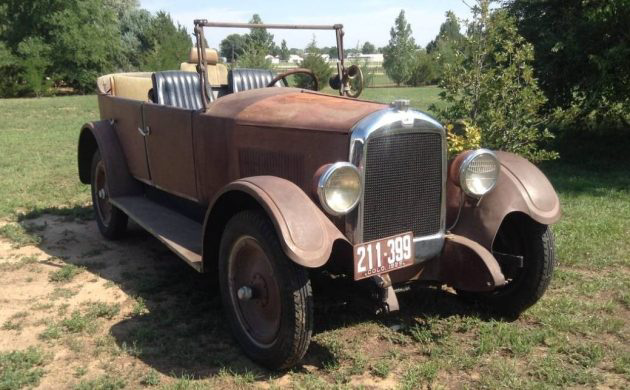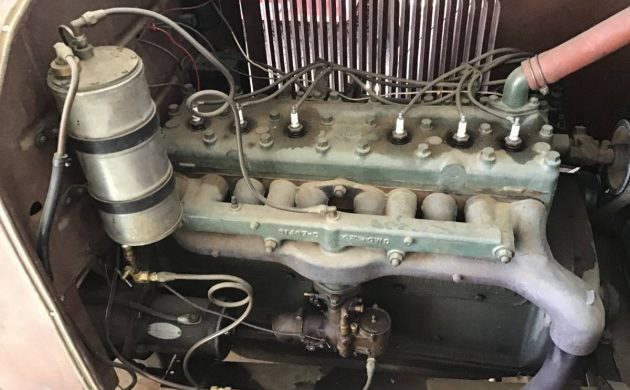If you’ve ever wanted to get into a classic from the Jazz Age, take a look at this 1925 Jewett Six Touring Car. Located in Hudson, just a few miles northeast of Denver, Colorado, this nonagenarian is advertised here on Craigslist for $6,500. Many thanks to Gunter Kramer for the tip!
The Jewett was a lower-range marque introduced by the Paige-Detroit Motor Car Company in 1922, providing entry-level cars with many of the same amenities as their upmarket Paige offerings. Named after the second president of the company, Harry M. Jewett, the brand would continue until 1926– the Graham Brothers bought Paige in 1927. Graham-Paige would continue making cars until 1940. The Jewett Six was a powerful car for its day, widely competing in hill climbs. In 1927, Paige automobiles took second and fourth place in the Pike’s Peak race. Their durability and performance served them well in export markets; the brand seems to have been popular in both Australia and New Zealand, neither known for accommodating driving conditions in the Twenties. Export was such an important component of sales that Paige manufactured right-hand drive models in Detroit alongside cars destined for American consumers.
The owner states that the engine is a 50 hp Continental, but this may be an error: the 1925 Jewett would have been equipped with a 55 hp six-cylinder designed in-house, and this looks like a lot like other Jewett engines. It’s safe to say that none of the seats are original, and there’s no word on the top, bumpers, or various and sundry other odds and ends that may or may not be included. The seller encourages interested parties to call for more information, and with a nearly antique vehicle from a relatively obscure manufacturer, it would be well worth the buyer’s time to determine what is missing in advance. He also notes that the hydraulic brakes and the steel wheels were factory options on this car.
Reviving a car like this one presents hurdles higher than owners of more popular models will experience. If your passion is the Ford Model A, it’s not impossible that you might find a new radiator cap, or a frame for the convertible top. With a Jewett, sourcing parts might require divine intervention, and for many pieces the new owner will likely be forced to fabricate new replacements. In many ways, and for the right person, this might be a worthwhile challenge. Mechanical and electrical systems should be easy to deal with, if only because there is so little with which to deal, and the dry mountain air has seemingly helped to preserve the steel and wood (check the cork on the clutch, though). As their original drivers are largely gone now, cars of this vintage have a niche appeal– especially given their limited utility. But as works of art and testaments to the skills of a generation of engineers and craftsmen, well cared-for examples rightly draw attention and admiration wherever they go. Here’s hoping someone with the skills, the time, the patience, and the money can make this car beautiful again.






I believe (guessing) the canister on the firewall is a fuel pump. It appears that intake manifold vacuum creates a vacuum in the canister which draws in fuel from the tank. The fuel is then gravity fed into the carburetor. As I said, I’m guessing so if you know for sure… chime in. I’d like to know. I have a project where I could make use of this idea.
JW454, you are correct in fact, it is often just referred to as a Vacuum Tank. Inside is a float and a float valve. If fuel is low or completely drained there is a small cap on top which you lift up and pour some fuel in to start the car. As the outside of the tank in the photo is bright colour I suspect it has been reskinned in aluminium or stainless steel. Such tanks were common on vehicles of the era and the normal camshaft driven diaphram pump introduced later on in the newer engine designs of the later 20’s and possibly up to 1930 if any of the older engine designs were carried over. Someone else on this forum might tell us when the last vacuum tank was fitted.
JW454… Tend to agree with you on the canister but I sure wouldn’t want that much fuel sitting over the exhaust manifolds, particularly with hard lines hooked to the engine. You won’t find me saying this too often about cars like this but this car would make a great driveline upgraded and painted street cruiser.
Something about that car, beautiful as it sits.
A testament to enduring time and weather.
I’d sort it out mechanically , preserve what’s there and let it be.
Discovered this one in South Africa about 15 years ago abandoned in a panel shop warehouse alongside an SS Aero and a Mercedes car similar to the open type that Hitler used to be driven around in. Sorry, I have no idea why the picture is downside up!
This looks like a Stewart-Warner vacuum tank. It is marvelously simple. The engine vacuum line creates low pressure in the tank which draws the fuel from the higher pressure gas tank. A float turns the vacuum on and off as needed so it is not filled with fuel, only the bottom of the tank. If something breaks or you lose vacuum you can take the top off, invert a 2 liter soda bottle fuel of gas and keep motoring! :)
I always look at an old car as an around town Sunday driver ::: Does not have to be restored Just perfect running gear and tires – Would not go on any major road, express way etc. Driving the cars of the 30s and 40s …No Air …. No Power anything …. Sometimes mechanical breaks … Maybe a cool spotlight and sun visor ….the little vent windows that you cranked open as well a the vent icy you hood to complete you air cooling …sometimes a Hydromatic magic or Power Drive transmission…. Some with free wheeling … this is more than cool … I Shute you old timers will agree
This is another antique that has no future other than get it running and putt around with the kids and say back in the day…..I didn’t notice if the seller says the engine runs. To make it drivable with it’s particular chassis, another matter, $3500. Tops.
Don’t write off all cars of the 20s and 30s as putt putts. I have a 1927 Hudson with a 288 CI F Head overhead valve 6. A stock Hudson sedan did 102 mph at Daytona and did 24 hours at an average speed of 78 mph. I can cruise easily at 60 mph but it does get exciting if someone stops suddenly in front of you.
The vaccum tank is marvelously simple. The vacuum in the tank lets the higher outside air pressure push/pull fuel from the gas tank. A float inside regulates the vacuum. If the system fails, usually due to a vacuum leak, you can remove the top of the vacuum tank and invert a 2 liter bottle of gas and keep on motoring.
With a whole 50 h.p. , that’s just enough to putt around town, no highway driving for this jewel!
I bought the 1925 Jewett. It is a project for sure but I did drive it before purchasing it. Now to sort out if I can get it running well enough to not upgrade the drivetrain!
Congratulations Doug. Enjoy.